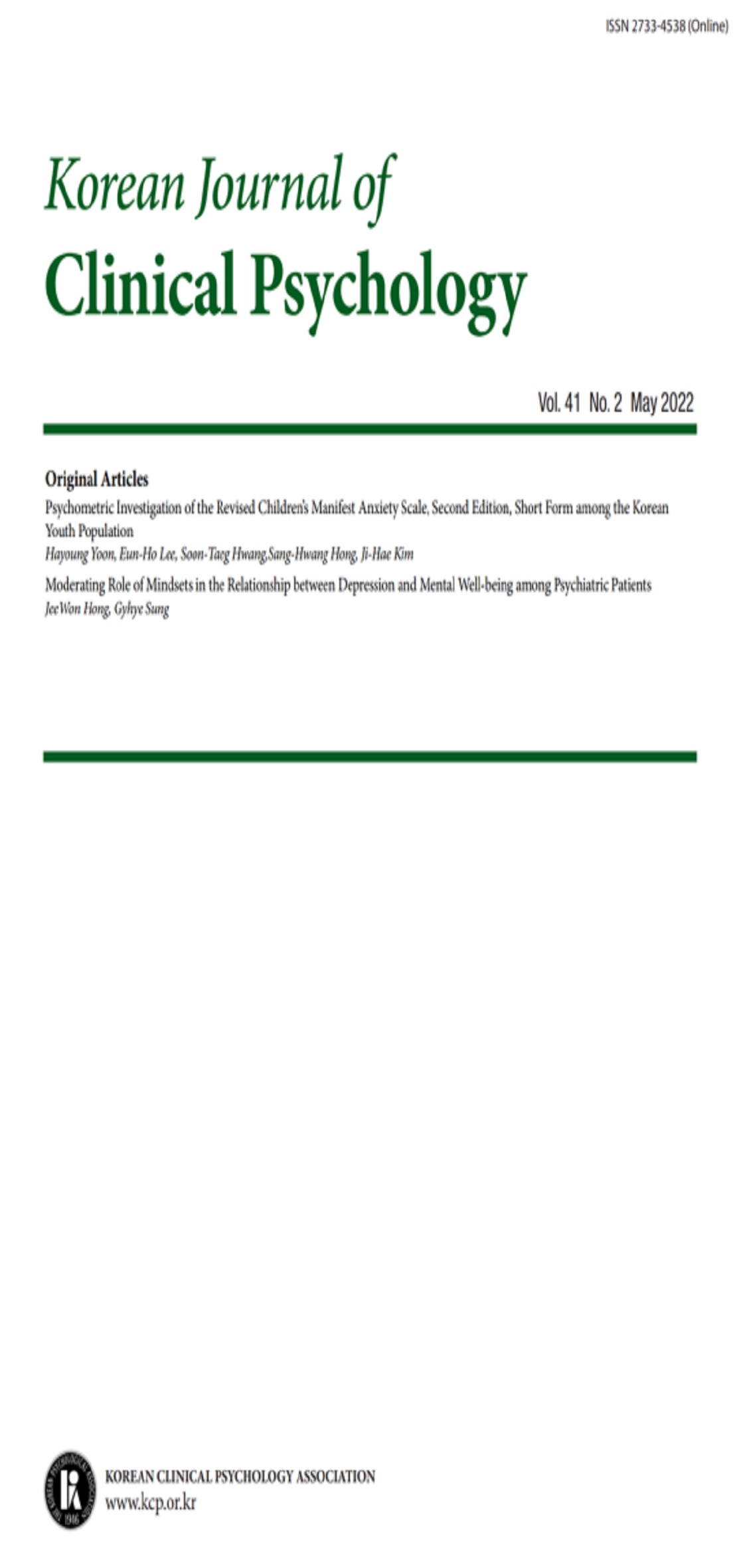open access
메뉴
open access
메뉴 E-ISSN : 2733-4538
E-ISSN : 2733-4538
This study developed an optimism improvement program and verified its effects. Seligman(1990) stated that optimism is not born but instead learned. His opinion was confirmed as an effective treatment by performing The Penn Prevention Program on children with depression. This study modified and complemented this program according to Korean children, and it developed a new optimism improvement program. To verify the effects of the program developed in this study, the program was conducted on a total of 57 fifth-grade elementary school students and first-grade middle school students. Fifty-eight persons as part of a waiting list control group in the same grade as the study subjects were also prepared. The optimism level of the group that participated in the program was significantly higher than that of the non-participants. This shows that alternative solution thinking ability was the mechanism of optimism improvement. In addition, as the result of checking whether or not alternative solution thinking ability and consequential thinking ability are key mediators of optimism improvement by means of parameter variables analysis, mediator effect of alternative solution thinking ability was verified while that of consequential thinking ability was not. This study is meaningful in that an optimism improvement program was developed according to Korean culture and actual conditions. It was economical as it could be performed in a shorter time than existing programs, and subjects were sufficient enough to verify the effects of the program.
강성희, 이재연 (1992). 아동의 적응에 있어서 사회적 지지와 사회적 문제해결 기술의 스트레스 완충효과에 대한 연구. 아동학회지, 13(2), 175-188.
김동현 (2006). 아동의 낙관성과 학습동기와의 관계. 서울대학교 교육대학원 석사학위 청구논문.
김미영 (2001). 아동의 인지적 대인관계 문제해결기술훈련 프로그램의 효과연구. 연세대학교 교육대학원 석사학위 청구논문.
김순복 (2007). 낙관성 향상 프로그램이 초등학교 아동의 자아탄력성과 학교생활 만족도에 미치는 영향. 서울교육대학교 석사학위 청구논문.
김주희 (1995). 낙관주의와 스트레스 대처방식 간의 관계. 중앙대학교 일반대학원 석사학위 청구논문.
동아일보 (2008, 10, 15). 강남학생 정신질환치료 전국 최다. 동아일보. http://www.donga. com에서 2009, 10, 15 인출.
문현미 (2006). 심리적 수용 촉진 프로그램의 개발과 효과: 수용-전념 치료 모델을 중심으로. 가톨릭대학교 대학원 박사학위 청구논문.
박영준 (1991). 대인관계 문제해결 기술훈련에 대한 실험적 연구: 초등학교 6학년 아동을 대상으로. 연세대학교 일반대학원 석사학위 청구논문.
배주미 (1991). 대인관계 문제해결 기술혼련에 대한 예비연구. 연세대학교 일반대학원 석사학위 청구논문.
성락인 (1992). 대인관계 문제해결 기술현련의 효과에 대한 연구. 연세대학교 일반대학원 석사학위 청구논문.
신성해 (2003). 낙관성 훈련이 초등학교 6학년 아동의 자아개념에 미치는 영향. 신라대학교 교육대학원석사학위 청구논문.
신현숙, 류정희, 이명자 (2005). 청소년의 낙관성과 비관성: 1-요인 모형과 2-요인 모형의 검증. 한국심리학회지: 학교, 2(1), 79- 97.
아시아투데이 (2008, 10, 5). 아동․청소년 정신질환 심각. 20면.
윤지혜 (2007). 낙관성이 우울과 안녕감에 미치는 영향: 사회적 지지와 대처양식을 매개변인으로. 아주대학교 일반대학원 석사학위 청구논문.
윤차선 (2002). 낙관성 훈련이 초등학교 4학년 학생의 우울성향에 미치는 효과. 신라대학교 교육대학원석사학위 청구논문.
이선화 (2007). 낙관성 증진 프로그램이 초등학생의 주관적 안녕감과 학교적응 유연성에 미치는 효과. 서울교육대학교 교육대학원 석사학위 청구논문.
장옥란 (2006). 낙관성 증진 집단 상담이 중학생의 낙관성, 대인관계 및 학교적응 유연성에 미치는 효과. 경성대학교 석사학위 청구논문.
조옥경 (1999). 낙관적-비관적 성향과 고등학생의 학교생활 적응과의 관계. 신라대학교 교육대학원 석사학위 청구논문.
Albee, G. W. (1959). Mental health manpower trends. New York: Basic Books.
Horowitz, J. L., & Garber, J. (2006). The prevention of depressive symptoms in children and adolescents: A meta-analytic review. Journal of Consulting and Clinical Psychology. 74(3), 401-415.
Johoda, M. (1953). The meaning of psychological health. Social Casework, 34, 349-354.
Judd, C. M., Kenny, D. A., & McClelland, G. H. (2001). Estimating and testing mediation and moderation in within-participant designs. Psychological Methods, 6, 115-134.
Mariellen, F., & Harold, L. (1996). Optimism and Pessimism in Elementary School-Aged Children. Journal of Child Development, 57(1), 241-248.
McLean, P. D. (1976a). Depression as a specific response to stress. In: R. J. Friendman and M. M. Katz(E.) The psychology of depression: Contemporary theory and research. New York: Wiley.
McLean, P. D. (1976b). Therapeutic decision- making in the behavioral treatment of depression. In: P. O. Davidson (ed.) The behavioral management of anxiety, depression, and pain. New York: Brunner/Mazel.
Peterson, C., & Bossio, L. M. (2000). Optimism & Pessimism: Implication for theory, research, and practice(127-145). Washington, DC: American Psychological Association.
Schulman, P., Castellon, C., & Seligman, M. E. P. (1989). Assessing explanatory style: The Content analysis of verbatim explanations and the Attributional Style Questionnaire. Behavior Research and Therapy, 27, 505-512.
Seligman, M. E. P. (1990). Learned Optimism. New York: Knopf.
Seligman, M. E. P. (1995). The Optimistic Child. Boston: Houghton Mifflin.
Seligman, M. E. P. (2000). 자녀에게 줄 최상의 선물은 낙관적인 인생관이다 [The Optimistic Child]. (박주성 역). 서울: 오리진. (원전은 1995년에 출판).
Shure, M. B. (1985). Interpersonal Problem-Solving: A cognitive approach to Behavior. In A. H. Robert, P. C. Anne-Nelly, & S. H. Joan(Eds.), Social Relationships and Cognitive Development, (pp.191-207). Oxford: Clarendon Press.
Shure, M. B. (1992a). I Can Problem Solve(ICPS): An Interpersonal Cognitive Problem Solving Program[kindergarten/primary grades], Champaign, IL: Research Press.
Shure, M. B. (1992b). Preschool Interpersonal Problem Solving(PIPS) test: Manual. Department of Mental Health Sciences, Hahnemann University, Philadelphia, PA.
Spivavack, G., Platt, J. J., & Shure, M. (1976). The problem-solving approach to adjustment. San Francisco: Jossey-Bass.
